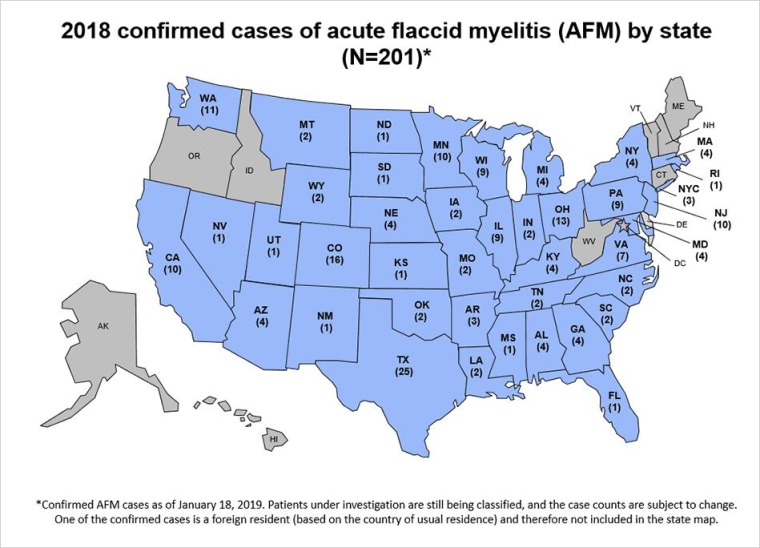More than 200 people, mostly young kids, developed the polio-like condition known as acute flaccid myelitis (AFM) in 2018, federal health officials report.
That makes last year the worst year on record for the condition, the Centers for Disease Control and Prevention reported in its latest update. More cases may be reported for 2018 because it can take several weeks for the CDC to confirm a suspected case.

But the CDC still doesn’t have a prime suspect, saying several different viruses have been associated with the symptoms.
“So far in 2018, there are 201 confirmed cases of AFM in 40 states,” the CDC said in its update. Another 163 suspected cases are being investigated.
The CDC says the condition, which resembles polio, is likely caused by a virus. Tests have shown several viruses in the bodies of patients, the CDC said.
“We detected coxsackievirus A16, EV-A71, and EV-D68 in the spinal fluid of four of 527 confirmed cases of AFM since 2014, which points to the cause of their AFM. For all other patients, no pathogen (germ) has been detected in their spinal fluid to confirm a cause,” it said.
But doctors say it’s not always easy to find a virus in patients who are not acutely infected — meaning they are showing the symptoms of infection. AFM often appears as an infection wanes, and it can take days for doctors to suspect the condition and start testing.
More than 80 percent of patients have had fevers and respiratory illnesses of some sort. EV-A71 and EV-D68 both cause respiratory infections. Coxsackievirus A16 causes hand, foot and mouth disease. Several patients have also had rhinovirus, which causes the common cold.
It’s also unclear whether a virus is directly attacking nerves, as poliovirus does, or is causing an autoimmune reaction, as seen in Guillain-Barré syndrome.
“No deaths have been reported among cases confirmed in 2018,” the CDC said.
But some of the patients are severely disabled. The condition is marked by a particular type of paralysis or weakness associated with a pattern of damage to the spinal cord. Some young children have required helped breathing using a ventilator.
Cases are also fitting into the every-other-year pattern the CDC has noticed since 2014. The number of cases being investigated has dropped sharply in recent weeks. But last year had the most cases on record. In 2014, when AFM first became widely noticed, 120 people were confirmed with the condition. This fell to 22 cases in 2015, went up to 149 cases in 2016 and again, fell to 35 cases in 2017.
That fits the pattern of a virus that circulates in some years and not in others, infectious disease experts say.
“Despite the increase in cases this year, AFM is still a rare disease,” the CDC said.



